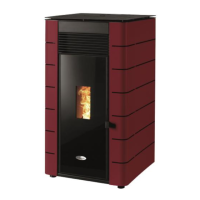13
Insulation: The fume ducts must be double-walled and insulated to make sure that fumes do not cool down going outwards,
which would cause an inadequate circulation and condensation that may damage the unit.
Where the flue draught is excessive it may be necessary to insert a “T-tube” with a regulator to regulate the flue draught.
Windproof terminal: A windproof terminal must always be installed to avoid the backflow of fumes.
Draught in the chimney: The figures below show three standard diagrams, specifying adequate lengths and diameters. Any
other type of installation must guarantee a draught of 12 Pa (0,12 mbars) measured when hot and at the maximum power.
Ventilation: To get the optimum operation of the unit it is necessary that the installation location has an air inlet with a
minimum section of 100 cm
2
, preferably near the back panel of the unit. The free-standing pellet fire unit has a circular
pipe (
∅
50mm) that may be connected to the exterior of the house.
If the residence has an air exhaust system installed (e.g., kitchen extractor fan), then ventilation of a required cross
sectional area to accommodate the different air exhaust units/systems must be installed.
The installation of the unit on locations near kitchen exhaust fans or fume extractors may prevent the unit from
operating properly.
6.4. Installation with a chimney
As shown in Figure 12, where the unit is installed with an exhaust pipe (∅80 mm for the K1200; ∅100 mm for the K1700 and
K2300) through the existing chimney, the chimney will be too large and must be lined with a flexible flue liner of appropriate
diameter, for 80 mm exhaust outlet increase to 100mm flexible flue, for 100mm exhaust outlet increase to125mm flexible flue.
A T-tube must be attached to the base of the pipe to allow for periodic inspection and annual maintenance, as illustrated in Figure
12.
Figure 12 - Side view of the installation with a chimney, showing the inspection point
We do not recommend that you use the unit in rough weather conditions that may seriously impact the draught (particularly with
very strong winds).
If you do not use the unit for a long time, check it to make sure that the flue pipes are clear before lighting the fire.
Inspection

